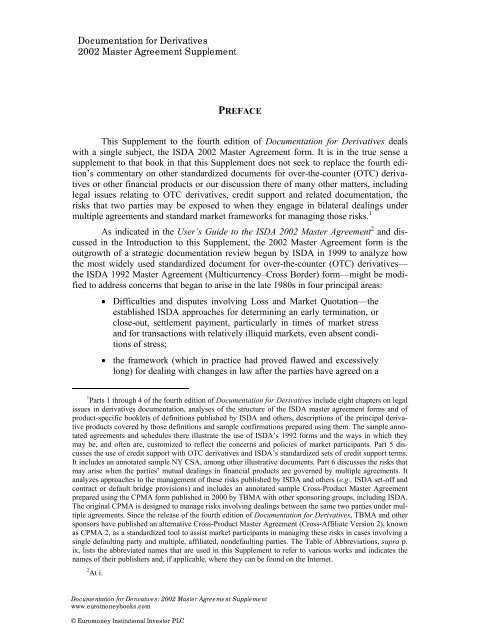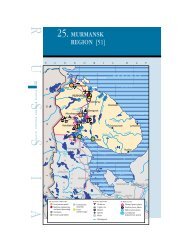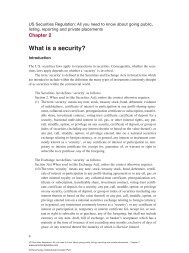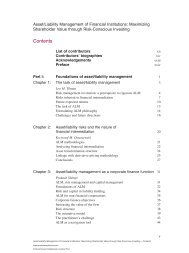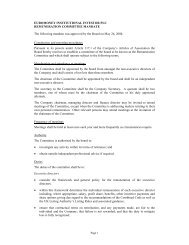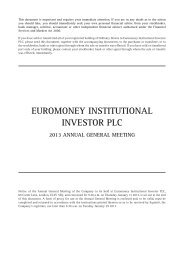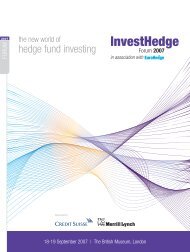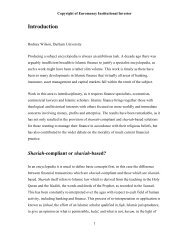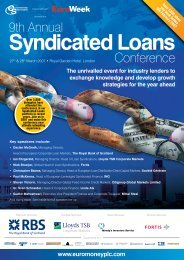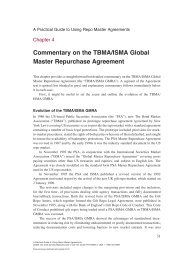Documentation for Derivatives 2002 Master Agreement Supplement
Documentation for Derivatives 2002 Master Agreement Supplement
Documentation for Derivatives 2002 Master Agreement Supplement
Create successful ePaper yourself
Turn your PDF publications into a flip-book with our unique Google optimized e-Paper software.
<strong>Documentation</strong> <strong>for</strong> <strong>Derivatives</strong><br />
<strong>2002</strong> <strong>Master</strong> <strong>Agreement</strong> <strong>Supplement</strong><br />
PREFACE<br />
This <strong>Supplement</strong> to the fourth edition of <strong>Documentation</strong> <strong>for</strong> <strong>Derivatives</strong> deals<br />
with a single subject, the ISDA <strong>2002</strong> <strong>Master</strong> <strong>Agreement</strong> <strong>for</strong>m. It is in the true sense a<br />
supplement to that book in that this <strong>Supplement</strong> does not seek to replace the fourth edition’s<br />
commentary on other standardized documents <strong>for</strong> over-the-counter (OTC) derivatives<br />
or other financial products or our discussion there of many other matters, including<br />
legal issues relating to OTC derivatives, credit support and related documentation, the<br />
risks that two parties may be exposed to when they engage in bilateral dealings under<br />
multiple agreements and standard market frameworks <strong>for</strong> managing those risks. 1<br />
As indicated in the User’s Guide to the ISDA <strong>2002</strong> <strong>Master</strong> <strong>Agreement</strong> 2 and discussed<br />
in the Introduction to this <strong>Supplement</strong>, the <strong>2002</strong> <strong>Master</strong> <strong>Agreement</strong> <strong>for</strong>m is the<br />
outgrowth of a strategic documentation review begun by ISDA in 1999 to analyze how<br />
the most widely used standardized document <strong>for</strong> over-the-counter (OTC) derivatives—<br />
the ISDA 1992 <strong>Master</strong> <strong>Agreement</strong> (Multicurrency–Cross Border) <strong>for</strong>m—might be modified<br />
to address concerns that began to arise in the late 1980s in four principal areas:<br />
• Difficulties and disputes involving Loss and Market Quotation—the<br />
established ISDA approaches <strong>for</strong> determining an early termination, or<br />
close-out, settlement payment, particularly in times of market stress<br />
and <strong>for</strong> transactions with relatively illiquid markets, even absent conditions<br />
of stress;<br />
• the framework (which in practice had proved flawed and excessively<br />
long) <strong>for</strong> dealing with changes in law after the parties have agreed on a<br />
1 Parts 1 through 4 of the fourth edition of <strong>Documentation</strong> <strong>for</strong> <strong>Derivatives</strong> include eight chapters on legal<br />
issues in derivatives documentation, analyses of the structure of the ISDA master agreement <strong>for</strong>ms and of<br />
product-specific booklets of definitions published by ISDA and others, descriptions of the principal derivative<br />
products covered by those definitions and sample confirmations prepared using them. The sample annotated<br />
agreements and schedules there illustrate the use of ISDA’s 1992 <strong>for</strong>ms and the ways in which they<br />
may be, and often are, customized to reflect the concerns and policies of market participants. Part 5 discusses<br />
the use of credit support with OTC derivatives and ISDA’s standardized sets of credit support terms.<br />
It includes an annotated sample NY CSA, among other illustrative documents. Part 6 discusses the risks that<br />
may arise when the parties’ mutual dealings in financial products are governed by multiple agreements. It<br />
analyzes approaches to the management of these risks published by ISDA and others (e.g., ISDA set-off and<br />
contract or default bridge provisions) and includes an annotated sample Cross-Product <strong>Master</strong> <strong>Agreement</strong><br />
prepared using the CPMA <strong>for</strong>m published in 2000 by TBMA with other sponsoring groups, including ISDA.<br />
The original CPMA is designed to manage risks involving dealings between the same two parties under multiple<br />
agreements. Since the release of the fourth edition of <strong>Documentation</strong> <strong>for</strong> <strong>Derivatives</strong>, TBMA and other<br />
sponsors have published an alternative Cross-Product <strong>Master</strong> <strong>Agreement</strong> (Cross-Affiliate Version 2), known<br />
as CPMA 2, as a standardized tool to assist market participants in managing these risks in cases involving a<br />
single defaulting party and multiple, affiliated, nondefaulting parties. The Table of Abbreviations, supra p.<br />
ix, lists the abbreviated names that are used in this <strong>Supplement</strong> to refer to various works and indicates the<br />
names of their publishers and, if applicable, where they can be found on the Internet.<br />
2 At i.<br />
<strong>Documentation</strong> <strong>for</strong> <strong>Derivatives</strong>: <strong>2002</strong> <strong>Master</strong> <strong>Agreement</strong> <strong>Supplement</strong><br />
www.euromoneybooks.com<br />
© Euromoney Institutional Investor PLC
xiv<br />
<strong>Documentation</strong> <strong>for</strong> <strong>Derivatives</strong> <strong>2002</strong> <strong>Master</strong> <strong>Agreement</strong> <strong>Supplement</strong><br />
transaction, if the changes render the per<strong>for</strong>mance bargained <strong>for</strong> by the<br />
parties illegal;<br />
• the lack of a framework <strong>for</strong> dealing with cases in which that per<strong>for</strong>mance<br />
is prevented or rendered impossible or impracticable by circumstances<br />
(such as governmental action, civil strife, natural disaster and<br />
acts of terrorism) not caused by and beyond the control of a party or a<br />
provider of credit support <strong>for</strong> its obligations; and<br />
• <strong>for</strong> a party that uses multiple agreements to document financial product<br />
dealings with a single counterparty, the substantive and timing differences<br />
in those agreements relating to grounds <strong>for</strong> close-out and the<br />
risks that these differences, and the use of multiple agreements more<br />
generally, may create. 3<br />
The strategic documentation initiative also addressed concerns relating to ISDA’s<br />
standard credit support documents—the Credit Support Annex (Bilateral Form) published<br />
by ISDA in 1994 <strong>for</strong> use with master agreements governed by New York law (the “NY<br />
CSA”) and the <strong>for</strong>m of Credit Support Annex published in 1995 <strong>for</strong> use in bilateral arrangements<br />
under English law involving credit support through transfers of title (the “Title<br />
Transfer CSA”). In this area, ISDA’s principal aims were to adopt terminology more<br />
nearly consistent with that used by collateral practitioners, to refine and tighten provisions<br />
on the delivery and release of collateral and the resolution of related disputes, to<br />
provide an alternative framework <strong>for</strong> the lock-up of collateral throughout the term of a<br />
transaction, where that practice is used in the particular market (e.g., equity derivatives)<br />
and to facilitate the cross-collateralization of the parties’ exposure to each other under<br />
their multiple dealing documents in a framework that calculates that exposure on a net<br />
basis. In 2001, ISDA addressed many of these issues by publishing amendments to its<br />
1992 master agreement <strong>for</strong>ms and the NY CSA and Title Transfer CSA, 4 as well as the<br />
Margin Provisions and the 2001 ISDA Cross-<strong>Agreement</strong> Bridge. 5<br />
As ISDA finalized these ef<strong>for</strong>ts, we incorporated them into the discussion and<br />
sample annotated documents that we were preparing <strong>for</strong> the fourth edition of <strong>Documentation</strong><br />
<strong>for</strong> <strong>Derivatives</strong>. However, lack of consensus on some features of the 2001 ISDA<br />
Amendments soon led to a reassessment of that project. An important focus of the reassessment<br />
was the substitution in the 2001 ISDA Amendments of an approach called “Replacement<br />
Value” <strong>for</strong> the 1992 ISDA <strong>for</strong>ms’ choices of Loss and Market Quotation as the<br />
possible means of calculating close-out settlement payments. In the course of that exercise,<br />
ISDA announced its intention to produce—rather than another round of amendment<br />
<strong>for</strong>ms—a new master agreement that would address the strategic documentation initiative<br />
3 See infra note 12 on the main risk.<br />
4 See <strong>Documentation</strong> <strong>for</strong> <strong>Derivatives</strong> 1057 <strong>for</strong> discussion of these and other approaches to credit support<br />
widely used in the derivatives market, as well as the key issues they raise and annotated sample credit support<br />
documents prepared using the NY CSA (including an illustration of how that ISDA <strong>for</strong>m, which assumes<br />
that each of the parties may be required to post support, may be modified so that only one party will<br />
be required to do so). The sample documents also include provisions on lock-up of collateral and, <strong>for</strong> those<br />
who cannot or are not inclined to post collateral, recouponing provisions.<br />
5 See <strong>Documentation</strong> <strong>for</strong> <strong>Derivatives</strong> 1281.<br />
<strong>Documentation</strong> <strong>for</strong> <strong>Derivatives</strong>: <strong>2002</strong> <strong>Master</strong> <strong>Agreement</strong> <strong>Supplement</strong><br />
www.euromoneybooks.com<br />
© Euromoney Institutional Investor PLC
Preface<br />
xv<br />
issues listed above, incorporate the results of the reassessment and make some structural<br />
and stylistic improvements to the 1992 <strong>Master</strong> <strong>Agreement</strong> (Multicurrency–Cross Border)<br />
<strong>for</strong>m while largely preserving the remainder of that <strong>for</strong>m as the model <strong>for</strong> the new agreement.<br />
We decided to release the fourth edition in July <strong>2002</strong> rather than to wait <strong>for</strong> publication<br />
of the new ISDA agreement, with the intention of preparing this separate treatment<br />
of the new <strong>for</strong>m when it became available.<br />
The new <strong>for</strong>m was published as the ISDA <strong>2002</strong> <strong>Master</strong> <strong>Agreement</strong> <strong>for</strong>m in January<br />
2003. Following this Preface, the Introduction to this <strong>Supplement</strong> summarizes the<br />
principal differences between the new <strong>for</strong>m and its 1992 predecessors. The remainder of<br />
this <strong>Supplement</strong> is set out in two parts. Part 1 of this <strong>Supplement</strong> consists of an annotated<br />
sample document prepared using the ISDA <strong>2002</strong> <strong>Master</strong> <strong>Agreement</strong> <strong>for</strong>m. The annotations<br />
provide greater detail on the differences summarized in the Introduction and explain<br />
how the provisions of the <strong>2002</strong> <strong>Master</strong> <strong>Agreement</strong> <strong>for</strong>m operate with each other. The annotations<br />
also refer throughout to the fourth edition of <strong>Documentation</strong> <strong>for</strong> <strong>Derivatives</strong>.<br />
The <strong>2002</strong> <strong>Master</strong> <strong>Agreement</strong> <strong>for</strong>m preserves substantial parts of ISDA’s 1992 <strong>Master</strong><br />
<strong>Agreement</strong> (Multicurrency—Cross Border) <strong>for</strong>m, and Part 3 of the fourth edition includes<br />
a sample master agreement prepared using that <strong>for</strong>m, with annotations that may be relevant<br />
to users of the <strong>2002</strong> <strong>Master</strong> <strong>Agreement</strong> <strong>for</strong>m as to the shared provisions of the 1992<br />
and <strong>2002</strong> <strong>for</strong>ms.<br />
Part 2 of this <strong>Supplement</strong> includes samples of three <strong>for</strong>ms of bilateral amendments<br />
that ISDA has published <strong>for</strong> use by those who are not inclined, at least <strong>for</strong> the present,<br />
to adopt the <strong>2002</strong> <strong>Master</strong> <strong>Agreement</strong> <strong>for</strong>m but who wish to amend their existing<br />
agreements and any related NY CSA or Title Transfer CSA to adopt the <strong>2002</strong> <strong>Master</strong><br />
<strong>Agreement</strong> <strong>for</strong>m approach, called “Close-out Amount,” to the calculation of early termination<br />
settlement payments. 6 Part 2 also includes an annotated version of the ISDA <strong>2002</strong><br />
<strong>Master</strong> <strong>Agreement</strong> Protocol, which was designed to facilitate amendments to agreements<br />
prepared using these and other ISDA publications identified in 18 Annexes to the Protocol<br />
by any two parties who adhere to the same Protocol Annexes, once those parties enter<br />
into an agreement based on the <strong>2002</strong> <strong>Master</strong> <strong>Agreement</strong> <strong>for</strong>m. As a general matter, the<br />
amendments implemented in the Protocol Annexes are limited to changes to the identified<br />
earlier ISDA documents—standardized credit support terms and product-specific booklets<br />
of definitions 7 —that are necessary to drop terminology from the 1992 <strong>Master</strong><br />
<strong>Agreement</strong> (Multicurrency—Cross Border) <strong>for</strong>m if that terminology is not used in the<br />
<strong>2002</strong> <strong>Master</strong> <strong>Agreement</strong> <strong>for</strong>m, and to make appropriate additions of terminology used in<br />
the <strong>2002</strong> <strong>Master</strong> <strong>Agreement</strong> <strong>for</strong>m but not in its 1992 predecessors. 8<br />
6 See infra p. 7 on the concerns about documentation basis risk that are behind the publication of the first<br />
of these amendments, the 2003 ISDA Close-out Amount Amendment Form set out in Part 2 to this <strong>Supplement</strong>,<br />
infra p. 115.<br />
7 See <strong>Documentation</strong> <strong>for</strong> <strong>Derivatives</strong> 369 on the various product-specific sets of definitions and how<br />
they are usually incorporated by reference into a master agreement prepared using an ISDA <strong>for</strong>m either<br />
through the confirmation <strong>for</strong> a specific transaction or in the master agreement schedule. Market participants<br />
should note that, since the publication of <strong>Documentation</strong> <strong>for</strong> <strong>Derivatives</strong>, ISDA has published new editions<br />
of some of the booklets discussed there.<br />
8 Thus, as illustrated infra p. 133, the amendments in the Protocol Annexes are somewhat prosaic and<br />
require little in the way of explanation. Typically, they replace references to the earlier ISDA master agreement<br />
<strong>for</strong>ms with references to the <strong>2002</strong> <strong>Master</strong> <strong>Agreement</strong> <strong>for</strong>m, they eliminate references to the Loss and<br />
<strong>Documentation</strong> <strong>for</strong> <strong>Derivatives</strong>: <strong>2002</strong> <strong>Master</strong> <strong>Agreement</strong> <strong>Supplement</strong><br />
www.euromoneybooks.com<br />
© Euromoney Institutional Investor PLC
xvi<br />
<strong>Documentation</strong> <strong>for</strong> <strong>Derivatives</strong> <strong>2002</strong> <strong>Master</strong> <strong>Agreement</strong> <strong>Supplement</strong><br />
In this <strong>Supplement</strong>, as in provisions of <strong>Documentation</strong> <strong>for</strong> <strong>Derivatives</strong> referred to<br />
here, we have expressed views that we have <strong>for</strong>med as a result of our practice with OTC<br />
derivatives, after taking into account the guidance notes or user’s guides published by<br />
ISDA and other associations or groups that have produced, or participated in the production,<br />
of the standardized agreements and other terms on which we comment, as well as<br />
the ever-growing literature on the subject. They are our views and should not be attributed<br />
to others, including our respective law firms or their clients. We have advised, and<br />
our law firms regularly represent, a number of the entities involved in some of the disputes<br />
described in <strong>Documentation</strong> <strong>for</strong> <strong>Derivatives</strong> and our other writings. In some cases,<br />
we or our firms have acted as counsel or filed amicus curiae briefs in connection with<br />
those disputes.<br />
The views expressed in this <strong>Supplement</strong> and in <strong>Documentation</strong> <strong>for</strong> <strong>Derivatives</strong><br />
should not be thought of as legal advice. The sample agreements and confirmations are<br />
merely illustrations involving hypothetical parties and circumstances, and they should not<br />
be used <strong>for</strong> actual agreements or transactions. The documentation <strong>for</strong> a transaction must<br />
be carefully tailored to address the legal issues affecting the particular parties and the<br />
characteristics of the transaction. The documentation must take into account the law as it<br />
stands at the time of the transaction in the relevant jurisdictions and the institutional policies<br />
of the parties and the business goals the parties are seeking to serve by engaging in<br />
the transaction.<br />
We wish to thank the International Swaps and <strong>Derivatives</strong> Association, Inc. <strong>for</strong><br />
permitting us to include some of their publications as the basis <strong>for</strong> the annotated documents<br />
included in this <strong>Supplement</strong>. We also wish to thank the many people, both colleagues<br />
and clients, who have helped and encouraged us over the years in our practice<br />
and writings.<br />
Anthony C. Gooch and Linda B. Klein<br />
January 15, 2004<br />
Market Quotation approaches in the 1992 master agreement <strong>for</strong>ms and replace them with references to the<br />
Close-out Amount concept introduced in the <strong>2002</strong> <strong>Master</strong> <strong>Agreement</strong> <strong>for</strong>m, and they take into account<br />
changes involving Illegality and Force Majeure Events, as well as to the confirmation process, as included in<br />
the <strong>2002</strong> <strong>Master</strong> <strong>Agreement</strong> <strong>for</strong>m. Rarely do they otherwise seek to amend the particular standardized terms<br />
covered by an Annex, although there is an occasional adoption of terminology from the 2000 ISDA Definitions<br />
in place of terminology from the 1991 ISDA Definitions.<br />
<strong>Documentation</strong> <strong>for</strong> <strong>Derivatives</strong>: <strong>2002</strong> <strong>Master</strong> <strong>Agreement</strong> <strong>Supplement</strong><br />
www.euromoneybooks.com<br />
© Euromoney Institutional Investor PLC


